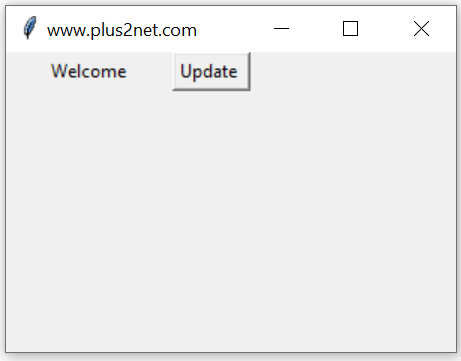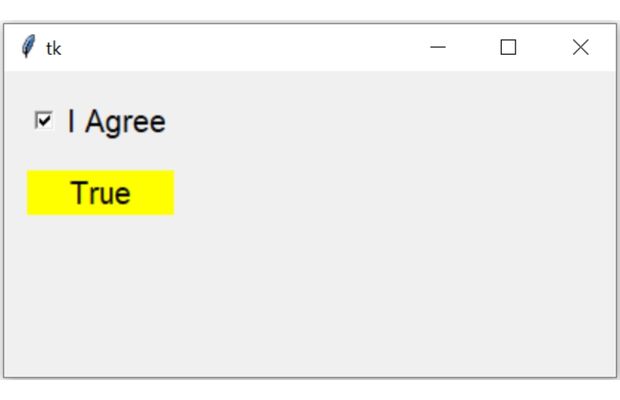Python tkinter BooleanVar() trace_add()
c_v=tk.BooleanVar(master,value,name)master: (Optional)The variable is associated with, default value is parent window.value:(Optional) We can set the initial value for the variable. name : (Optional) Name given default is PY_VAR1
Tkitner BooleanVar() get(), set(), trace() methods to manage data and trigger call back functions
trace_add()
trace_add(self, mode, callback)read :Read - the variable is read by someone
write :Write- the variable is written ( updated ) by someone ( frequently used).
unset :undefined – The variable is deleted
or a list or tuple of such strings.
db1.trace_add(['write','read'],my_r) # callback when data changes
Here is an example which uses w ( write ) mode to display the value of the variable when ever it changes.
We used one Button and used on Click event to change the value of this variable bv1 from False to True.
b1 = tk.Button(my_w,text='Update',command=lambda:bv1.set(True))trace_add method is used to attach 'observer' callbacks to the variable
import tkinter as tk
from tkinter import *
my_w = tk.Tk()
my_w.geometry("300x100") # Size of the window
my_w.title("www.plus2net.com") # Adding a title
def my_r(*args):
print(bv1.get()) # Print when variable changes.
bv1 = tk.BooleanVar(my_w) # declare Boolean Variable
bv1.set(0)
b1 = tk.Button(my_w,text='Update',command=lambda:bv1.set(1))
b1.grid(row=2,column=3,padx=30,pady=10)
bv1.trace_add('write',my_r) # monitor the change of variable
my_w.mainloop()TrueUse DoubleVar() for handling Float Data
Use IntVar() for handling Integer Data
set() and get() methods of BooleanVar
In above examples we used set() method to assign data to the Boolean variable and to read the data stored we used get() method. These two methods are frequently used in our scripts.bv1.set(1) # assign value to bv1
print(bv1.get()) # display the value assigned to bv1Initializing BooleanVar
We can using set() method to assign data to BooleanVar, after declaring or we can assign value while declaring the string variable.bv1=tk.BooleanVar(value=True) # Assign value to bv1Length of BooleanVar
Before using len function, we have to convert the BooleanVar to string by using str()print(len(str(bv1.get()))) # 4 Normal Variable and BooleanVar
BooleanVar() is a class in Tkinter. In a GUI application we require various events to be captured to trigger different functions (requirements). If we use normal Python variable with widgets then monitoring the changes is difficult. However by using a BooleanVar we can monitor the changes and trigger functions based on the requirements.Reading Checkbuton status using BooleanVar

We will connect the variable option of a Checkbutton to BooleanVar() c_v and read the status.
By using trace_add() method of Boolean variable we will trigger a call back function.
Inside the function we will read the value of Boolean variable by using get() method and then update the text attribute of a Label by using config() method.
import tkinter as tk
my_w = tk.Tk()
my_w.geometry("400x200") # Size of the window
c_v=tk.BooleanVar()# Declaring the Boolean variable
c_v.set(1) # Set the value to 2
c1=tk.Checkbutton(my_w,text='I Agree',variable=c_v,
onvalue=1,offvalue=0,font=20)
c1.grid(row=0,column=0,padx=15,pady=15)
l1=tk.Label(my_w,text='Output',font=22,bg='yellow')
l1.grid(row=1,column=0,padx=15,sticky='ew')
def my_upd(*args):
my_data=c_v.get() # read the value or state of the Checkbutton
l1.config(text=str(my_data)) # Update the Label with data
c_v.trace_add('write',my_upd) # On change of Boolean variable trigger function
my_upd() # Update function
my_w.mainloop() # Keep the window openStringVar() DoubleVar() IntVar()

Subhendu Mohapatra
Author
🎥 Join me live on YouTubePassionate about coding and teaching, I publish practical tutorials on PHP, Python, JavaScript, SQL, and web development. My goal is to make learning simple, engaging, and project‑oriented with real examples and source code.
Subscribe to our YouTube Channel here
This article is written by plus2net.com team.
https://www.plus2net.com

 Python Video Tutorials
Python Video Tutorials